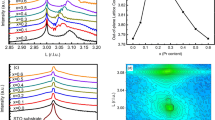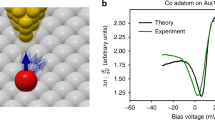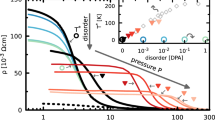Abstract
The electrical conductance of atomic metal contacts represents a powerful tool for detecting nanomagnetism. Conductance reflects magnetism through anomalies at zero bias1,2,3,4,5,6,7—generally with Fano line shapes—owing to the Kondo screening of the magnetic impurity bridging the contact8,9. A full atomic-level understanding of this nutshell many-body system is of the greatest importance, especially in view of our increasing need to control nanocurrents by means of magnetism. Disappointingly, at present, zero-bias conductance anomalies are not calculable from atomistic scratch. Here, we demonstrate a working route connecting approximately but quantitatively density functional theory (DFT) and numerical renormalization group (NRG) approaches and leading to a first-principles conductance calculation for a nanocontact, exemplified by a Ni impurity in a Au nanowire. A Fano-like conductance line shape is obtained microscopically, and shown to be controlled by the impurity s-level position. We also find a relationship between conductance anomaly and geometry, and uncover the possibility of opposite antiferromagnetic and ferromagnetic Kondo screening—the latter exhibiting a totally different and unexplored zero-bias anomaly. The present matching method between DFT and NRG should permit the quantitative understanding and exploration of this larger variety of Kondo phenomena at more general magnetic nanocontacts.
This is a preview of subscription content, access via your institution
Access options
Subscribe to this journal
Receive 12 print issues and online access
$259.00 per year
only $21.58 per issue
Buy this article
- Purchase on Springer Link
- Instant access to full article PDF
Prices may be subject to local taxes which are calculated during checkout



Similar content being viewed by others
References
Knorr, N., Schneider, M. A., Diekhöner, L., Wahl, P. & Kern, K. Kondo effect of single Co adatoms on Cu surfaces. Phys. Rev. Lett. 88, 096804 (2002).
Zhao, A. et al. Controlling the Kondo effect of an adsorbed magnetic ion through its chemical bonding. Science 309, 1542–1544 (2005).
Neel, N. et al. Conductance and Kondo effect in a controlled single-atom contact. Phys. Rev. Lett. 98, 016801 (2007).
Otte, A. F. et al. The role of magnetic anisotropy in the Kondo effect. Nature Phys. 4, 847–850 (2008).
Vitali, L. et al. Kondo effect in single atom contacts: The importance of the atomic geometry. Phys. Rev. Lett. 101, 216802 (2008).
Ternes, M., Heinrich, A. & Schneider, W.-D. Spectroscopic manifestations of the Kondo effect on single adatoms. J. Phys. Condens. Matter 21, 053001 (2009).
Reyes-Calvo, M. et al. The Kondo effect in ferromagnetic atomic contacts. Nature 458, 1150–1153 (2009).
Hewson, A. The Kondo Problem to Heavy Fermions (Cambridge Univ. Press, 1993).
Újsághy, O., Kroha, J., Szunyogh, L. & Zawadowski, A. Theory of the Fano resonance in the STM tunneling density of states due to a single Kondo impurity. Phys. Rev. Lett. 85, 2557–2560 (2000).
Kouwenhoven, L. P. et al. in Mesoscopic Electron Transport (eds Sohn, L. L., Kouwenhoven, L. P. & Schon, G.) (Kluwer, 1997).
Joon Choi, H. & Ihm, J. Ab initio pseudopotential method for the calculation of conductance in quantum wires. Phys. Rev. B 59, 2267–2275 (1999).
Bulla, R., Costi, T. A. & Pruschke, T. Numerical renormalization group method for quantum impurity systems. Rev. Mod. Phys. 80, 395–451 (2008).
Glazman, L. I. & Raikh, M. E. Resonant Kondo transparency of a barrier with quasilocal impurity states. JETP Lett. 47, 452–455 (1988).
Ng, T. K. & Lee, P. A. On-site Coulomb repulsion and resonant tunneling. Phys. Rev. Lett. 61, 1768–1771 (1988).
Meir, Y. & Wingreen, N. S. Landauer formula for the current through an interacting electron region. Phys. Rev. Lett. 68, 2512–2515 (1992).
Bagrets, A., Papanikolaou, N. & Mertig, I. Conduction eigenchannels of atomic-sized contacts: Ab initio KKR Green’s function formalism. Phys. Rev. B 75, 235448 (2007).
Miura, Y., Mazzarello, R., Dal Corso, A., Smogunov, A. & Tosatti, E. Monatomic Au wire with a magnetic Ni impurity: Electronic structure and ballistic conductance. Phys. Rev. B 78, 205412 (2008).
Gunnarsson, O., Andersen, O. K., Jepsen, O. & Zaanen, J. Density-functional calculation of the parameters in the Anderson model: Application to Mn in CdTe. Phys. Rev. B 39, 1708–1722 (1989).
Costi, T. A. et al. Kondo decoherence: Finding the right spin model for iron impurities in gold and silver. Phys. Rev. Lett. 102, 056802 (2009).
Koller, W., Hewson, A. C. & Meyer, D. Singular dynamics of underscreened magnetic impurity models. Phys. Rev. B 72, 045117 (2005).
Nozières, P. & Blandin, A. Kondo effect in real metals. J. Phys. (Paris) 41, 193–211 (1980).
Perdew, J. P., Burke, K. & Ernzerhof, M. Generalized gradient approximation made simple. Phys. Rev. Lett. 77, 3865–3868 (1996).
Giannozzi, P. et al. <http://www.quantum-espresso.org>.
Vanderbilt, D. Soft self-consistent pseudopotentials in a generalized eigenvalue formalism. Phys. Rev. B 41, 7892–7895 (1990).
Smogunov, A., Dal Corso, A. & Tosatti, E. Ballistic conductance of magnetic Co and Ni nanowires with ultrasoft pseudopotentials. Phys. Rev. B 70, 045417 (2004).
Datta, S. Electronic Transport in Mesoscopic Systems (Cambridge Studies in Semiconductor Physics and Microelectronic Engineering, 1997).
Costi, T. A., Hewson, A. C. & Zlatic, V. Transport coefficient of the Anderson model via the numerical renormalization group. J. Phys. Condens. Matter 6, 2519–2558 (1994).
Acknowledgements
We would like to thank D. Basko and C. Untiedt for very useful discussions. The work was supported by the Italian Ministry of University and Research, through a PRIN-COFIN award, and by INFM through ‘Iniziativa Trasversale Calcolo Parallelo’. The environment provided by the independent ESF project CNR-FANAS-AFRI was also useful. P.L. acknowledges financial support from EC STREP project MIDAS ‘Macroscopic Interference Devices for Atomic and Solid State Physics’ and CNR-INFM within ESF Eurocores Programme FoNE-Spintra.
Author information
Authors and Affiliations
Contributions
P.L., M.F. and E.T. conceived and elaborated the Kondo aspects, including NRG; R.M. and A.S. worked out the DFT part, from which A.S. extracted the phase shifts. E.T. wrote the paper, with help from all co-authors.
Corresponding author
Supplementary information
Supplementary Information
Supplementary Information (PDF 247 kb)
Rights and permissions
About this article
Cite this article
Lucignano, P., Mazzarello, R., Smogunov, A. et al. Kondo conductance in an atomic nanocontact from first principles. Nature Mater 8, 563–567 (2009). https://doi.org/10.1038/nmat2476
Received:
Accepted:
Published:
Issue Date:
DOI: https://doi.org/10.1038/nmat2476
This article is cited by
-
Computational design of magnetic molecules and their environment using quantum chemistry, machine learning and multiscale simulations
Nature Reviews Chemistry (2022)
-
Kondo blockade due to quantum interference in single-molecule junctions
Nature Communications (2017)
-
Metallic, magnetic and molecular nanocontacts
Nature Nanotechnology (2016)
-
A tunable two-impurity Kondo system in an atomic point contact
Nature Physics (2011)
-
The importance of being entangled
Nature Materials (2009)



